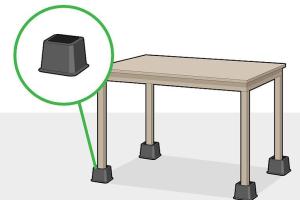Elevate Your Space: Effective Techniques to Raise the Height of a Table

-
Quick Links:
- Introduction
- Why Raise Table Height?
- Methods to Raise Table Height
- Step-by-Step Guide to Raising Table Height
- Expert Insights and Case Studies
- Tools Needed
- Safety Tips
- Maintenance of Raised Tables
- Conclusion
- FAQs
Introduction
Have you ever found yourself straining to reach the food on your table, or maybe struggling to get comfortable while working from home? Raising the height of a table can transform your dining experience or work setup. In this article, we will explore various methods to effectively elevate your table, ensuring both style and functionality.
Why Raise Table Height?
Raising your table height can be beneficial for several reasons:
- Comfort: A table at the right height improves posture and comfort.
- Accessibility: Helps accommodate taller individuals and those with mobility issues.
- Style: A higher table can complement your interior design, creating a more modern aesthetic.
- Functionality: Allows for multi-purpose use, such as converting a dining table into a workspace.
Methods to Raise Table Height
There are several techniques to elevate your table. Here are some of the most popular methods:
1. Adding Table Risers
Table risers are a simple solution to increase height. They come in various materials and designs, allowing you to choose one that matches your table.
2. Using Furniture Coasters
Furniture coasters can add a few inches to your table height. They are also useful for protecting floors from scratches.
3. Modifying Legs
For a more permanent solution, consider replacing the table legs with longer ones. This method requires some woodworking skills.
4. Employing Adjustable Legs
Adjustable legs allow you to customize the height of the table based on your needs.
5. Layering with a Tablecloth
A thicker tablecloth can provide a temporary solution, making the table appear higher without any permanent modifications.
Step-by-Step Guide to Raising Table Height
Follow these steps to ensure a successful elevation of your table:
Step 1: Measure Your Current Table Height
Use a measuring tape to determine the current height of your table. This will help you decide how much you need to raise it.
Step 2: Choose Your Method
Based on your preferences and skills, select one of the methods mentioned above.
Step 3: Gather Necessary Tools
Depending on your chosen method, you may need tools such as a drill, screws, wood glue, or a saw.
Step 4: Implement Changes
Follow the instructions relevant to your chosen method carefully.
Step 5: Test the Stability
Once modified, test the table for stability and ensure it can hold the weight of items placed on it.
Expert Insights and Case Studies
According to furniture designer Sarah Johnson, "Raising a table can significantly enhance the usability of a space. I've seen many clients convert their dining areas into multifunctional spaces by simply adjusting their table height."
Tools Needed
- Measuring tape
- Drill
- Screws
- Wood glue
- Saw (if modifying legs)
- Leveling tool
Safety Tips
When raising your table, ensure the following:
- Wear safety goggles while using power tools.
- Check that the table is stable before placing heavy items on it.
- Work in a well-ventilated area if using strong adhesives.
Maintenance of Raised Tables
To maintain your raised table, regularly check for stability and tighten any screws or joints as necessary. If you’ve used risers, inspect them for wear and tear.
Conclusion
Raising the height of a table can dramatically enhance your comfort and functionality in your home or office. By following the steps and methods outlined in this article, you can easily modify your table to fit your needs and style.
FAQs
1. How high should a dining table be?
The standard height for a dining table is between 28 to 30 inches.
2. Can I use furniture risers on any table?
Yes, furniture risers can be used on most tables as long as they are compatible with the table's leg design.
3. Is it difficult to replace table legs?
Replacing table legs can be simple if you have the right tools and follow the instructions carefully.
4. How do I know if my table is stable after raising it?
Test the table by placing weight on it and checking for wobbling or instability.
5. Can I raise a table without damaging it?
Yes, methods like using furniture coasters or risers can raise a table without permanent modifications.
6. Are adjustable legs worth it?
Adjustable legs are versatile and can be worth the investment if you frequently change your table's use.
7. How can I decorate a raised table?
Consider using table runners or decorative centerpieces that complement the new height.
8. What materials are best for table risers?
Wood, plastic, and metal are common materials for table risers; choose based on aesthetics and strength.
9. Can I raise a coffee table?
Yes, many of the same methods can be applied to coffee tables as well.
10. What should I do if my table wobbles after raising it?
Check for level and stability, and adjust or reinforce the legs or risers as needed.